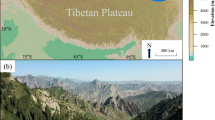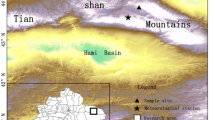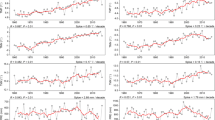Abstract
Our study examines the application of using blue intensity (BI) methods to develop a late summer maximum temperature (Tmax) reconstruction for the Southern Rocky Mountains—a mid-latitude (i.e., 36° N), arid region in North America. We reconstruct August–September (AS) Tmax for the period 1735–2015 CE using a composite latewood BI (LWB) Engelmann spruce (Picea engelmannii Parry ex Engelm.) chronology from multiple sites across the Sangre de Cristo Mountains in Northern New Mexico, USA. This study presents the first BI-derived temperature reconstruction for the lower mid-latitudes (30–45° N) of North America. We compare the climate response of multiple tree-ring parameters: LWB, earlywood BI (EWB), ∆BI (earlywood BI minus latewood BI), ring width (RW), and maximum latewood density (MXD). Of all parameters, the site-composite LWB and ∆BI chronologies show the strongest correlations with AS Tmax. Reconstructed AS Tmax demonstrates fluctuating warm and cool periods during the latter portion of the Little Ice Age (ca. 1730–1850) and pronounced warming through the early to mid-twentieth century (ca. 1920–1950s). The reconstruction also documents substantial warming over the last decade, the trend of which appears to be anomalous within the context of the past ca. 280 years. We highlight the potential for BI methods to be successfully used at high-elevation, mid-latitude locations where temperature proxy datasets are scarce or non-existent. As many places across the mid-latitudes lack contiguous, temporally resolved, decadal-scale paleotemperature proxies, we suggest here that BI methods can be effective at improving the spatial gaps in the Northern Hemisphere temperature proxy network.





Similar content being viewed by others
References
Akaike H (1974) A new look at the statistical model identification. IEEE Trans Autom Control 19(6):716–723
Alexander R, Sheppard W (1984) Silvicultural characteristics of Engelmann spruce. USDA Forest Service general technical report RM 114
Anchukaitis KJ, D’Arrigo RD, Andreu-Hayles L, Frank D, Verstege A, Curtis A, Buckley BM, Jacoby GC, Cook ER (2013) Tree-ring-reconstructed summer temperatures from northwestern North America during the last nine centuries. J Clim 26(10):3001–3012
Anchukaitis KJ, Wilson R, Briffa KR, Büntgen U, Cook ER, D’Arrigo R, Davi N, Esper J, Frank D, Gunnarson BE et al (2017) Last millennium Northern Hemisphere summer temperatures from tree rings: part ii, spatially resolved reconstructions. Quat Sci Rev 163:1–22
Biondi F, Perkins D, Cayan D, Hughes M (1999) July temperature during the second millennium reconstructed from Idaho tree rings. Geophys Res Lett 26(10):1445–1448
Björklund J, Gunnarson BE, Seftigen K, Esper J, Linderholm H (2014) Blue intensity and density from northern fennoscandian tree rings, exploring the potential to improve summer temperature reconstructions with earlywood information. Clim Past 10(2):877–885
Björklund J, Gunnarson BE, Seftigen K, Zhang P, Linderholm HW (2015) Using adjusted blue intensity data to attain high-quality summer temperature information: a case study from central scandinavia. The Holocene 25(3):547–556
Björklund J, Seftigen K, Schweingruber F, Fonti P, von Arx G, Bryukhanova MV, Cuny HE, Carrer M, Castagneri D, Frank DC (2017) Cell size and wall dimensions drive distinct variability of earlywood and latewood density in Northern Hemisphere conifers. New Phytol 216(3):728–740
Björklund J, von Arx G, Nievergelt D, Wilson R, Van den Bulcke J, Günther B, Loader N, Rydval M, Fonti P, Scharnweber T, et al. (2019) Scientific merits and analytical challenges of tree-ring densitometry. Rev Geophys
Blunden J, Arndt DS (2016) State of the climate in 2016. Bull Am Meteorol Soc 98(8):Si–S280
Briffa KR, Jones PD, Schweingruber FH (1988) Summer temperature patterns over Europe: a reconstruction from 1750 A.D. based on maximum latewood density indices of conifers. Quat Res 30(1):36–52
Briffa KR, Jones P, Schweingruber F (1992) Tree-ring density reconstructions of summer temperature patterns across western North America since 1600. J Clim 5(7):735–754
Briffa KR, Osborn TJ, Schweingruber FH, Harris IC, Jones PD, Shiyatov SG, Vaganov EA (2001) Low-frequency temperature variations from a northern tree ring density network. J Geophys Res Atmos 106(D3):2929–2941
Briffa KR, Osborn TJ, Schweingruber FH, Jones PD, Shiyatov SG, Vaganov EA (2002) Tree-ring width and density data around the Northern Hemisphere: part 1, local and regional climate signals. The Holocene 12(6):737–757
Brookhouse M, Graham R (2016) Application of the minimum blue-intensity technique to a Southern-Hemisphere conifer. Tree-Ring Res 72(2):103–107
Buckley BM, Hansen KG, Griffin KL, Schmiege S, Oelkers R, D’Arrigo RD, Stahle DK, Davi N, Nguyen TQT, Le CN et al (2018) Blue intensity from a tropical conifers annual rings for climate reconstruction: an ecophysiological perspective. Dendrochronologia 50:10–22
Büntgen U, Frank D, Wilson R, Carrer M, Urbinati C, Esper J (2008) Testing for tree-ring divergence in the European Alps. Glob Chang Biol 14(10):2443–2453
Campbell R, McCarroll D, Loader NJ, Grudd H, Robertson I, Jalkanen R (2007) Blue intensity in Pinus sylvestris tree-rings: developing a new palaeoclimate proxy. The Holocene 17(6):821–828
Cayan DR, Kammerdiener SA, Dettinger MD, Caprio JM, Peterson DH (2001) Changes in the onset of spring in the Western United States. Bull Am Meteorol Soc 82(3):399–416
Cayan DR, Das T, Pierce DW, Barnett TP, Tyree M, Gershunov A (2010) Future dryness in the southwest us and the hydrology of the early 21st century drought. Proc Natl Acad Sci 107(50):21271–21276
Cook ER, Kairiukstis LA (2013) Methods of dendrochronology: applications in the environmental sciences. Springer Science & Business Media
Cook ER, Meko DM, Stahle DW, Cleaveland MK (1999) Drought reconstructions for the continental United States. J Clim 12(4):1145–1162
Cook BI, Miller RL, Seager R (2008) Dust and sea surface temperature forcing of the 1930s Dust Bowl drought. Geophys Res Lett 35(8)
Cook BI, Miller RL, Seager R (2009) Amplification of the North American Dust Bowl drought through human-induced land degradation. Proc Natl Acad Sci 106(13):4997–5001
Cook ER, Palmer JG, Ahmed M, Woodhouse CA, Fenwick P, Zafar MU, Wahab M, Khan N (2013) Five centuries of upper indus river flow from tree rings. J Hydrol 486:365–375
Cook BI, Smerdon JE, Seager R, Cook ER (2014) Pan-continental droughts in North America over the last millennium. J Clim 27(1):383–397
D’Arrigo R, Wilson R, Liepert B, Cherubini P (2008) On the divergence problem in northern forests: a review of the tree-ring evidence and possible causes. Glob Planet Chang 60(3–4):289–305
Daly C, Neilson RP, Phillips DL (1994) A statistical-topographic model for mapping climatological precipitation over mountainous terrain. J Appl Meteorol 33(2):140–158
Data UC (2019) Temperature - precipitation - sunshine - snowfalls
Davi NK, Jacoby GC, Wiles GC (2003) Boreal temperature variability inferred from maximum latewood density and tree-ring width data, Wrangell Mountain region, Alaska. Quat Res 60(3):252–262
Durbin J, Watson GS (1971) Testing for serial correlation in least squares regression. iii. Biometrika 58(1):1–19
Fritts H (1976) Tree rings and climate. Elsevier
Fuentes M, Salo R, Björklund J, Seftigen K, Zhang P, Gunnarson B, Aravena JC, Linderholm HW (2018) A 970-year-long summer temperature reconstruction from Rogen, west-central Sweden, based on blue intensity from tree rings. The Holocene 28(2):254–266
Garfin G, Franco G, Blanco H, Comrie A, Gonzalez P, Piechota T, Smyth R,Waskom R (2014) Southwest: the third National Climate Assessment. In: Climate change impacts in the United States: the third National Climate Assessment, US Global Change Research Program, pp 462–486
Gindl W, Grabner M, Wimmer R (2000) The influence of temperature on latewood lignin content in treeline Norway spruce compared with maximum density and ring width. Trees 14(7):409–414
Guttman L (1954) Some necessary conditions for common-factor analysis. Psychometrika 19(2):149–161
Harley GL, Maxwell JT (2018) Current declines of Pecos river (New Mexico, USA) streamflow in a 700-year context. The Holocene 28(5):767–777
Harley GL, Maxwell JT, Larson E, Grissino-Mayer HD, Henderson J, Huffman J (2017) Suwannee river flow variability 1550–2005 CE reconstructed from a multispecies tree-ring network. J Hydrol 544:438–451
Harley GL, Maxwell RS, Black BA, Bekker MF (2020) A multi-century, tree-ring-derived perspective of the north cascades (USA) 2014–2016 snow drought. Climatic Change pp 1–17
Heeter KJ, Harley GL, Van De Gevel SL, White PB (2019) Blue intensity as a temperature proxy in the Eastern United States: a pilot study from a southern disjunct population of Picea rubens (Sarg.). Dendrochronologia 55:105–109
Holmes RL (1983) Computer-assisted quality control in tree-ring dating and measurement
Jacoby GC, D’Arrigo R (1989) Reconstructed Northern Hemisphere annual temperature since 1671 based on high-latitude tree-ring data from North America. Clim Chang 14(1):39–59
Jardine A, Merideth R, Black M, LeRoy S (2013) Assessment of climate change in the Southwest United States: a report prepared for the National Climate Assessment. Island
Jones PD, New M, Parker DE, Martin S, Rigor IG (1999) Surface air temperature and its changes over the past 150 years. Rev Geophys 37(2):173–199
Kaczka RJ, Spyt B, Janecka K, Beil I, Büntgen U, Scharnweber T, Nievergelt D, Wilmking M (2018) Different maximum latewood density and blue intensity measurements techniques reveal similar results. Dendrochronologia 49:94–101
Kaiser HF (1960) The application of electronic computers to factor analysis. Educ Psychol Meas 20(1):141–151
Larsson L (2014) CooRecorder and CDendro programs of the CooRecorder/CDendro package version 7.7
Linderholm HW, Björklund J, Seftigen K, Gunnarson BE, Fuentes M (2015) Fennoscandia revisited: a spatially improved tree-ring reconstruction of summer temperatures for the last 900 years. Clim Dyn 45(3–4):933–947
Little EL, Viereck LA (1971) Atlas of United States trees, vol 5. US Dept. of Agriculture, Forest Service
Luckman B, Wilson R (2005) Summer temperatures in the Canadian rockies during the last millennium: a revised record. Clim Dyn 24(2–3):131–144
Maxwell JT, Harley GL (2017) Increased tree-ring network density reveals more precise estimations of sub-regional hydroclimate variability and climate dynamics in the Midwest, USA. Clim Dyn 49(4):1479–1493
Maxwell RS, Harley GL, Maxwell JT, Rayback SA, Pederson N, Cook ER, Bar-clay DJ, Li W, Rayburn JA (2017) An interbasin comparison of tree-ring reconstructed streamflow in the Eastern United States. Hydrol Process 31(13):2381–2394
McCarroll D, Pettigrew E, Luckman A, Guibal F, Edouard JL (2002) Blue reflectance provides a surrogate for latewood density of high-latitude pine tree rings. Arct Antarct Alp Res 34(4):450–453
Melvin TM, Briffa KR (2008) A signal-free approach to dendroclimatic standardisation. Dendrochronologia 26(2):71–86
Melvin TM, Briffa KR, Nicolussi K, Grabner M (2007) Time-varying-response smoothing. Dendrochronologia 25(1):65–69
Mooney H, Larigauderie A, Cesario M, Elmquist T, Hoegh-Guldberg O, Lavorel S, Mace GM, Palmer M, Scholes R, Yahara T (2009) Biodiversity, climate change, and ecosystem services. Curr Opin Environ Sustain 1(1):46–54
Neukom R, Steiger N, Gómez-Navarro JJ, Wang J, Werner JP (2019) No evidence for globally coherent warm and cold periods over the preindustrial Common Era. Nature 571(7766):550–554
NOAA (2016) National Centers for Environmental information. Climate at a Glance: Regional Mapping. https://www.ncdc.noaa.gov, https://www.ncdc.noaa.gov/cag/
Oliver JS, Harley GL, Maxwell JT (2019) 2,500 years of hydroclimate variability in New Mexico, USA. Geophys Res Lett 46(8):4432–4440
Parker M, Henoch W (1971) The use of Engelmann spruce latewood density for dendrochronological purposes. Can J For Res 1(2):90–98
Rydval M, Larsson LÅ, McGlynn L, Gunnarson BE, Loader NJ, Young GH, Wilson R (2014) Blue intensity for dendroclimatology: should we have the blues? Experiments from Scotland. Dendrochronologia 32(3):191–204
Salzer MW, Kipfmueller KF (2005) Reconstructed temperature and precipitation on a millennial timescale from tree-rings in the southern Colorado Plateau, USA. Clim Chang 70(3):465–487
Schneider L, Smerdon JE, Büntgen U, Wilson RJ, Myglan VS, Kirdyanov AV, Esper J (2015) Revising midlatitude summer temperatures back to A.D. 600 based on a wood density network. Geophys Res Lett 42(11):4556–4562
Schweingruber F (1988) A new dendroclimatic network for western North America. Dendrochronologia 6:171–180
Schweingruber FH, Briffa KR (1996) Tree-ring density networks for climate reconstruction. In: Climatic variations and forcing mechanisms of the last 2000 years, Springer, pp 43–66
Schweingruber F, Briffa K, Nogler P (1993) A tree-ring densitometric transect from Alaska to Labrador. Int J Biometeorol 37(3):151–169
Seager R, Kushnir Y, Ting M, Cane M, Naik N, Miller J (2008) Would advance knowledge of 1930s SSTs have allowed prediction of the Dust Bowl drought? J Clim 21(13):3261–3281
Sheppard PR, Graumlich LJ, Conkey LE (1996) Reflected-light image analysis of conifer tree rings for reconstructing climate. The Holocene 6(1):62–68
Speer JH (2010) Fundamentals of tree-ring research. University of Arizona Press
Stoffel M, Khodri M, Corona C, Guillet S, Poulain V, Bekki S, Guiot J, Luckman BH, Oppenheimer C, Lebas N et al (2015) Estimates of volcanic-induced cooling in the Northern Hemisphere over the past 1,500 years. Nat Geosci 8(10):784
Stokes M, Smiley T (1968) An introduction to tree-ring dating. University of Chicago Press, Chicago
Thornton PK, Ericksen PJ, Herrero M, Challinor AJ (2014) Climate variability and vulnerability to climate change: a review. Glob Chang Biol 20(11):3313–3328
Trouet V, Van Oldenborgh GJ (2013) KNMI Climate Explorer: a Web-based research tool for high-resolution paleoclimatology. Tree-Ring Res 69(1):3–14
Trouet V, Diaz H, Wahl E, Viau A, Graham R, Graham N, Cook E (2013) A 1500-year reconstruction of annual mean temperature for temperate North America on decadal-to-multidecadal time scales. Environ Res Lett 8(2):024008
Udall B, Overpeck J (2017) The twenty-first century Colorado River hot drought and implications for the future. Water Resour Res 53(3):2404–2418
Vinod HD, Lopez-de Lacalle J (2009) Maximum entropy bootstrap for time series: the meboot R package. J Stat Softw 29(5):1–19
Wahl ER, Smerdon JE (2012) Comparative performance of paleoclimate field and index reconstructions derived from climate proxies and noise-only predictors. Geophys Res Lett 39(6)
Weiss JL, Castro CL, Overpeck JT (2009) Distinguishing pronounced droughts in the southwestern United States: seasonality and effects of warmer temperatures. J Clim 22(22):5918–5932
Westerling AL, Hidalgo HG, Cayan DR, Swetnam TW (2006) Warming and earlier spring increase western us forest wildfire activity. Science 313(5789):940–943
Wigley TM, Briffa KR, Jones PD (1984) On the average value of correlated time series, with applications in dendroclimatology and hydrometeorology. J Clim Appl Meteorol 23(2):201–213
Wiles GC, D’Arrigo RD, Barclay D, Wilson RS, Jarvis SK, Vargo L, Frank D (2014) Surface air temperature variability reconstructed with tree rings for the Gulf of Alaska over the past 1200 years. The Holocene 24(2):198–208
Wiles G, Charlton J, Wilson RJ, D’Arrigo R, Buma B, Krapek J, Gaglioti BV, Wiesenberg N, Oelkers R (2019) Yellow-cedar blue intensity tree ring chronologies as records of climate, Juneau, Alaska, USA. Can J For Res
Wilson RJ, Luckman BH (2003) Dendroclimatic reconstruction of maximum summer temperatures from upper treeline sites in interior British Columbia, Canada. The Holocene 13(6):851–861
Wilson R, D’Arrigo R, Buckley B, Büntgen U, Esper J, Frank D, Luckman B, Payette S, Vose R, Youngblut D (2007a) A matter of divergence: tracking recent warming at hemispheric scales using tree ring data. J Geophys Res Atmos 112(D17)
Wilson R, Wiles G, D’Arrigo R, Zweck C (2007b) Cycles and shifts: 1,300 years of multi-decadal temperature variability in the Gulf of Alaska. Clim Dyn 28(4):425–440
Wilson R, Rao R, Rydval M, Wood C, Larsson LÅ, Luckman BH (2014) Blue intensity for dendroclimatology: the BC blues: a case study from British Columbia, Canada. The Holocene 24(11):1428–1438
Wilson R, Anchukaitis K, Briffa KR, Büntgen U, Cook E, D’Arrigo R, Davi N, Esper J, Frank D, Gunnarson B et al (2016) Last millennium Northern Hemisphere summer temperatures from tree rings: part i: the long term context. Quat Sci Rev 134:1–18
Wilson R, D’Arrigo R, Andreu-Hayles L, Oelkers R, Wiles G, Anchukaitis K, Davi N (2017a) Experiments based on blue intensity for reconstructing North Pacific temperatures along the Gulf of Alaska. Clim Past
Wilson R, Wilson D, Rydval M, Crone A, Büntgen U, Clark S, Ehmer J, Forbes E, Fuentes M, Gunnarson BE et al (2017b) Facilitating tree-ring dating of historic conifer timbers using blue intensity. J Archaeol Sci 78:99–111
Wilson R, Anchukaitis K, Andreu-Hayles L, Cook E, D’Arrigo R, Davi N, Haberbauer L, Krusic P, Luckman B, Morimoto D, et al. (2019) Improved dendroclimatic calibration using blue intensity in the southern Yukon. The Holocene p 0959683619862037
Zang C, Biondi F (2015) treeclim: an R package for the numerical calibration of proxy-climate relationships. Ecography 38(4):431–436
Acknowledgments
JT Maxwell and students were supported during the field sample collection by the Indiana University Institute for Advanced Study. We would like thank Lamar Gillespie, George Harley, Lola Harley, Douglas Heruska, Randy Matheaus, Joshua Oliver, Karly Schmidt, Kerri Spuller, Brandon Strange, and Michael Thornton for their assistance with the data collection, Rob Wilson, and the two anonymous reviewers for their very thorough edits and suggestions that improved earlier drafts of this manuscript.
Funding
We would like to thank the University of Idaho and Indiana University for the financial support of this project.
Author information
Authors and Affiliations
Corresponding author
Additional information
Publisher’s note
Springer Nature remains neutral with regard to jurisdictional claims in published maps and institutional affiliations.
Electronic supplementary material
ESM 1
(PDF 35255 kb)
Rights and permissions
About this article
Cite this article
Heeter, K.J., Harley, G.L., Maxwell, J.T. et al. Late summer temperature variability for the Southern Rocky Mountains (USA) since 1735 CE: applying blue light intensity to low-latitude Picea engelmannii Parry ex Engelm. Climatic Change 162, 965–988 (2020). https://doi.org/10.1007/s10584-020-02772-9
Received:
Accepted:
Published:
Issue Date:
DOI: https://doi.org/10.1007/s10584-020-02772-9




